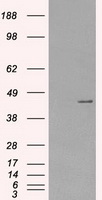Protein Kinase A regulatory subunit I alpha (PRKAR1A) Mouse Monoclonal Antibody [Clone ID: OTI6C7]
CAT#: TA500641S
Anti-PRKAR1A (PKA regulatory subunit I alpha) mouse monoclonal antibody, clone OTI6C7 (formerly 6C7)
Size: 100 ul
Frequently bought together (3)
Other products for "PRKAR1A"
Specifications
| Product Data | |
| Clone Name | OTI6C7 |
| Applications | IF, IHC, WB |
| Recommended Dilution | WB 1:2000, IHC 1:50, IF 1:100 |
| Reactivities | Human, Mouse, Rat |
| Host | Mouse |
| Isotype | IgG1 |
| Clonality | Monoclonal |
| Immunogen | Full-length protein expressed in 293T cell transfected with human PRKAR1A expression vector |
| Formulation | PBS (pH 7.3) containing 1% BSA, 50% glycerol and 0.02% sodium azide. |
| Concentration | 1 mg/ml |
| Purification | Purified from mouse ascites fluids or tissue culture supernatant by affinity chromatography (protein A/G) |
| Conjugation | Unconjugated |
| Storage | Store at -20°C as received. |
| Stability | Stable for 12 months from date of receipt. |
| Predicted Protein Size | 43.0 kDa |
| Gene Name | protein kinase cAMP-dependent type I regulatory subunit alpha |
| Database Link | |
| Background | cAMP is a signaling molecule important for a variety of cellular functions. cAMP exerts its effects by activating the cAMP-dependent protein kinase, which transduces the signal through phosphorylation of different target proteins. The inactive kinase holoenzyme is a tetramer composed of two regulatory and two catalytic subunits. cAMP causes the dissociation of the inactive holoenzyme into a dimer of regulatory subunits bound to four cAMP and two free monomeric catalytic subunits. Four different regulatory subunits and three catalytic subunits have been identified in humans. This gene encodes one of the regulatory subunits. This protein was found to be a tissue-specific extinguisher that down-regulates the expression of seven liver genes in hepatoma x fibroblast hybrids. Mutations in this gene cause Carney complex (CNC). This gene can fuse to the RET protooncogene by gene rearrangement and form the thyroid tumor-specific chimeric oncogene known as PTC2. A nonconventional nuclear localization sequence (NLS) has been found for this protein which suggests a role in DNA replication via the protein serving as a nuclear transport protein for the second subunit of the Replication Factor C (RFC40). Three alternatively spliced transcript variants encoding the same protein have been observed. |
| Synonyms | ACRDYS1; ADOHR; CAR; CNC; CNC1; PKR1; PPNAD1; PRKAR1; TSE1 |
| Reference Data | |
| Protein Families | Druggable Genome, Transcription Factors |
| Protein Pathways | Apoptosis, Insulin signaling pathway |
Documents
| Product Manuals |
| FAQs |
Resources
| Antibody Resources |
{0} Product Review(s)
0 Product Review(s)
Submit review
Be the first one to submit a review
Product Citations
*Delivery time may vary from web posted schedule. Occasional delays may occur due to unforeseen
complexities in the preparation of your product. International customers may expect an additional 1-2 weeks
in shipping.






























































































































































































































































 Germany
Germany
 Japan
Japan
 United Kingdom
United Kingdom
 China
China
















